Property development feasibility study - A land subdivision case study
Let's look at a detailed Property Development feasibility study for a land subdivision project. This case study is from my students' real-life project a few years ago. I have changed some details to maintain their privacy.
This size project requires more effort and resolve than a simple 2-3 lot subdivision you might do when getting started, but it's good to see how it all came together for them.
A land development feasibility study is different from a standard property development feasibility. It is used to assess the best yield for land subdivision and calculate the residual value of land.

Project background
This is a JV joint venture with the landowner. One of the students knew someone who wanted to offload a property with a Koala reserve.
They didn't know what to do with it, so they asked around if they could sell it. Luckily, they knew someone who knew my students, let's call them Mr X & Mr Y., And somehow Mr X & Y presented themselves to them and offered to help. Rest is history.
So let's see how two of these students made history.
An elderly couple owned this large parcel of land with a significant portion that fell under a protective Koala reserve. They didn't want the hassle of developing it themselves, but at the same time, they wanted more for their land based on its development potential.
Learn More
Land subdivision process: Can I subdivide my land/property?
The question they wanted to answer was, Can I subdivide my land/property? The easiest way to determine if you can subdivide any property is by…

1) Neighbourhood character
Jump on Google Maps and check if any similar properties have been subdivided. This gives a very good idea of whether there is a precedent set for what you are trying to do.
You can quickly determine setbacks, frontages and minimum land size to subdivide etc., and gauge quickly whether you can subdivide your property.
This approach is typical for small-scale projects with 2-4 lot subdivisions.
Ideally, the minimum land size that can be subdivided is 600m2 or more. However, this is determined by the property's zoning and permissible land use.
2) Zoning and overlays
Check out zoning and overlays. A simple search for #zoning maps and #land use on Google will show you zoning maps in your city.
In particular, you are looking for information on planning schemes, subdivision applications, zoning and overlays to determine the permissible use of the site.
In our example above, we identified that the property was zone low-density residential but had protective overlays. A large section of the property was deemed a Koala habitat and needed to be protected.
In other words, even though the site was big enough to warrant a large subdivision, a significant portion of land fell under the Koala protection reserve, which was a problem because it directly translated to fewer lots.
3) Property development feasibility study - Land subdivision
The above two steps will help you determine the zoning & neighbourhood character. Let's presume your land is subdividable; now what?
You need to figure out whether or not this is financially viable for your project.
This is where a property development feasibility study is so important.
A lot can be done on any property, i.e. whatever its permissible use and zoning allow you to develop and unlock its potential, however…
Is subdividing the land financially feasible/viable for you?
The land subdivision application process
Land subdivision application should be the least of your concern if you have just started investigating. You can go through the above three steps without ever leaving your computer.
Unless you are doing a large land development, you do not even need to spend money with consultants. Your number one priority should be to figure out whether you have enough funds to do the project on your own.
Anyway, let's continue with our case study and the feasibility of the land development.
Following the steps above, MR X & Y determined that the zoning was conducive to land development and identified a Koala protection overlay on their site.
But the critical information they identified was that the land was almost unencumbered, i.e. it had very little debt.
Land subdivision - deal structure
I cannot reveal too many details for privacy reasons.
The structure was a property option agreement with a combination of JV with the land owner to buy the land at a pre-determined price post-development approval & pre-sales.
The land owner got what they were happy with for their land, and Mr X & Y got to do the entire project with the least amount of money or developers' equity.
They wanted to negate & postpone the need for organising finance unless they were ready to commence site works.
Impact of deal structure on property development feasibility
In the project feasibility, you need to make sure of 2 things.
- The land is allowed to be used as equity, and the landowner is paid for the land at a pre-determined rate either at the end of the project or just before commencing the project.
- The developer can use the equity in the land to leverage and get debt against it.
Before the feasibility study
Mr X & Y had to complete a thorough feasibility study of the project. This required understanding every step in detail and determining all the costs of subdividing the land, which you can do by purchasing our property development checklists [power bundle].

Highest best use
They determined the highest and best use for the land. During their initial exercise, their land surveyor drew a plan without determining the site zoning and overlay requirements.
This is what happens when you base your assumptions on half-baked information. The land surveyor wasn't wrong but assumed that they could develop over the Koala protection zone.
This is also what happens when you try and acquire a site that is advertised with STCA.
What is STCA?
STCA stands for Subject To Council Approval. Most sites with development potential are advertised with STCA in their description. Real estate agents do that to highlight a property's development potential, which increases the project's perceived value.
What STCA, does not mean?
STCA only means that the site has development potential and that you MAY get a permit to develop the site. STCA does not guarantee the permit or how many lots or units can be developed/built under permissible use.
This is where most amateur developers end up paying more for the site based on a preliminary subdivision plan (like the one below) without further investigation.
The preliminary plan of subdivision below outlines the 25 lots that can fit on the site easily within building requirements.
There is, however, no guarantee that the purchaser will be able to get a DA (development approval) / planning permit for 25 lots.
In our case study, initially, Mr X & Y were both excited to learn that they could fit 25 lots which meant that they could split 1 single lot into 25 lots and sell each for a profit.
However, further investigation revealed that they could only get approval for 15 lots due to the zoning and the Koala overlay.
So they had to settle with 15 lots only due to low-density requirements and overlays on 1.619 hectares, which was still a great outcome, and they made still made a killing.
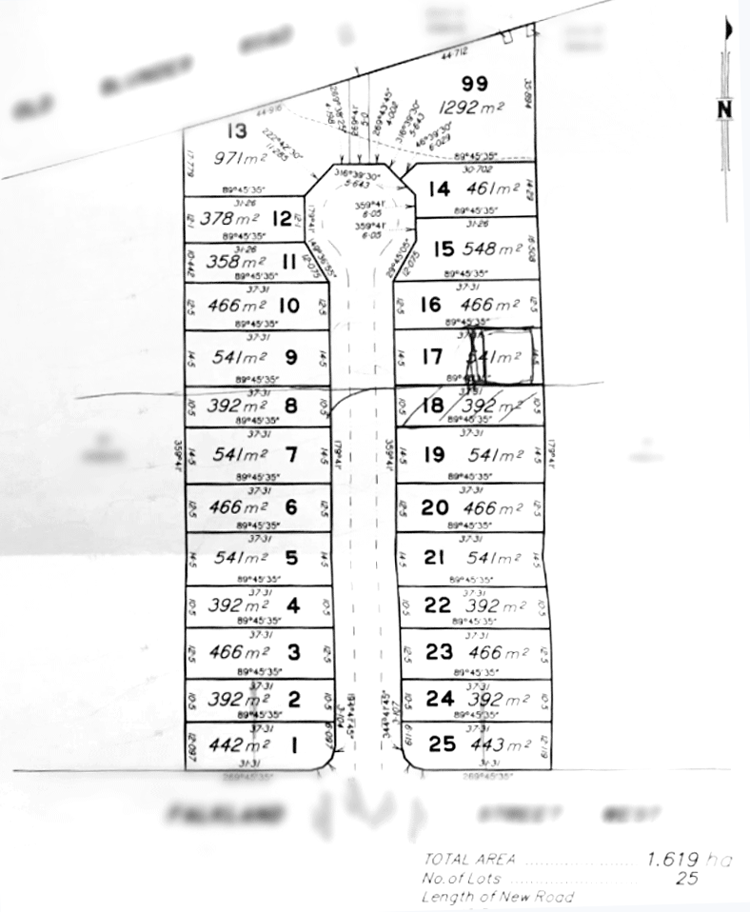
Joint venture agreement
After numerous meetings with the landowner and their lawyers and the legal team representing the landowner, they decided to keep the transaction clean. They agreed to purchase the site for $1.5m, however, to keep things clean instead of a JV with the land owner, they put together a call option agreement as explained above.
Property valuation
In a JV agreement, usually a valuation is undertaken to ascertain the current value or the ‘as is’ value of the property before a development permit is obtained. However, since the landowner wanted to keep things clean, they opted to go with an options agreement.
So the property title stayed in the owners’ name until 1) they had obtained the permit and 2) they were ready for site works to get all services to the site. This reduced their holding costs considerably because they did not have to close the sale until they were ready to break ground.
The real estate development team consisted of a town planner to deal with the Koala reserve and vegetation protection overlay, a land surveyor and a civil engineer to plan the services that needed connecting to the site.
Property development feasibility study - land subdivision
One Minute Feasibility - Back of the envelope feasibility on steroids
A high-level feasibility study to quickly understand if the project had any legs. At this stage, they didn’t know exactly the total number of lots they could develop.
The preliminary plan of subdivision showed 25 lots, but they understood that this was the best-case scenario and it was highly likely that they may not get a permit to develop over the Koala reserve section on their property.
Plus, at this stage, they did not have the complete consultant costs, so they did a feasibility study using averages.
This type of feasibility is often known as back-of-the-envelope feasibility, but with One Minute Feaso, we’ve kept the convenience and speed of the back-of-the-envelope feasibility but made it more detailed. In other words, One Minute Feaso is like your back-of-the-envelope feasibility on steroids.
Watch the video below to see the One Minute Feasibility in action.

Feasibility Study Example
Check out the published version of the preliminary feasibility assessment discussed in the video above.
Or sign up for a free 7-day trial here for One Minute Feaso.
Land development feasibility study checklist
The video below is not related to this particular case study, nonetheless, if you wish to understand the complete land development process and have a detailed checklist of all costs associated with subdividing land, please watch this video first.

Property development feasibility - Land subdivision
At this stage, Mr. X and Mr. Y had done their thorough due diligence in terms of costs, and they were pretty confident that it was very likely that they would get a development permit to develop 15-16 lots.
I requested that they use our Smart Property Development Feasibility Calculator to calculate the sub-division costs for this level of development feasibility for two reasons.
The SFC (Smart Feasibility Calculator) allowed them to enter unlimited lots and sizes, and it was detailed enough to provide a funding table and more control over various assumptions.
Because their project timeline was a maximum of 10 months of construction, a detailed cash flow feasibility study would have been overkill. And for such projects, using the Smart Feasibility Calculator is a smarter option.Why?
Because when a project starts and finishes within 12-36 months, property development metrics like IRR and NPV become less important in decision-making.
Learn More
Here’s the thing with property development feasibility study. One size does not fit all. You need a different feasibility tool or software for different stages and types of property.
You cannot bring a tank to a gunfight. In a gunfight, you must have the right gun. For a fistfight, you need a trained fist. For a knife fight, you need to have the right knife. If you show up at every fight with a tank, not only will it cost you more, but it will also be unproductive and time-consuming. Not to mention that you need a tonne of paid training to use a tank.
That’s the reason we have developed and are continuously developing property development feasibility software applications to cater to various different types of projects.
Get The Edge Now!
Discover the transformative power of our FREE EDGE platform and
unlock a world of opportunities at no cost!
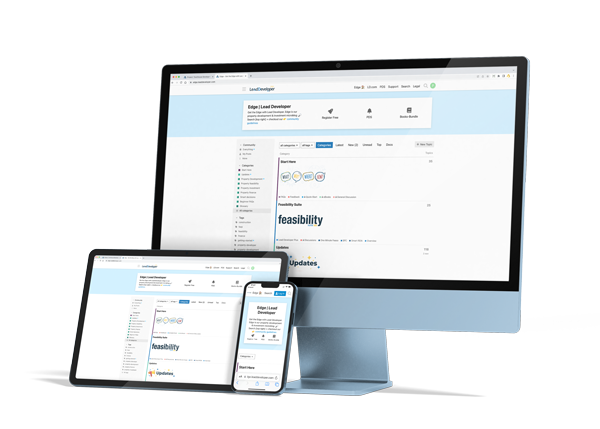
Your Real Estate Toolkit Awaits!
Free eBooks, Courses & Feasibility Suite Trial—Join Today!
✓ Unlimited FREE Trial: Experience the full power of our Feasibility Suite with hands-on demos
—explore without limits, no time pressure & without commitment or credit card!
✓ Learn from Success: Dive into real-life case studies for practical insights.
✓ Engage, Inquire, and Innovate: Ask questions, request features, and engage in lively discussions.
✓ Showcase Your Projects and Gain Insights: Share your projects and get personalised feedback.
✓ Free Resources Galore: Access a treasure trove of free resources,
eBooks & courses to keep you informed.
✓ Exclusive Training: Enjoy members-only training to sharpen your skills.

Property development feasibility assumptions - Land development
Here is a video with a complete walkthrough of the land development feasibility study using our [Smart] Development Feasibility Calculator
Feasibility Study Example
Here is a published sample of property development feasibility report.
Or Sign up for Smart Feasibility Calculator.
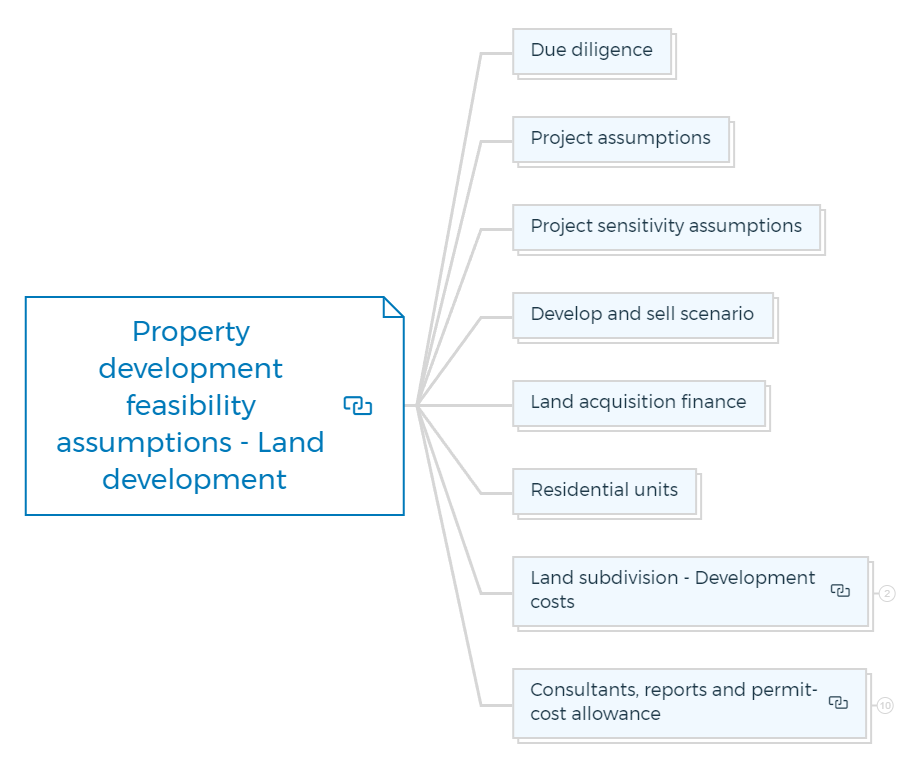
Due diligence
Initially, they took advantage of all the site-specific knowledge provided by the surveyor, planner, and engineer. All due diligence concerns related to town planning and engineering were tackled in a series of meetings between Mr X and Mr Y, and the consultants.
Project assumptions
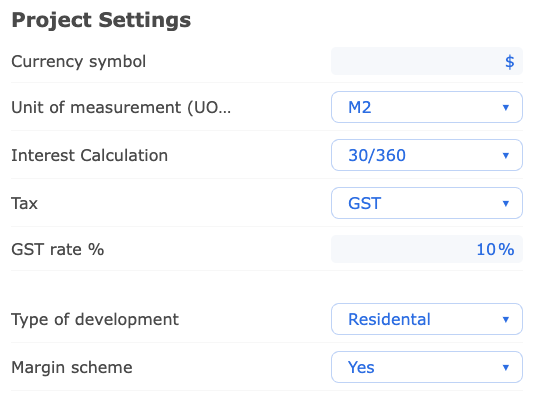
Project settings for property development feasibility are stock standards. You select whether or not the margin scheme applies and you select the right method of interest rate calculation.
Project sensitivity assumptions
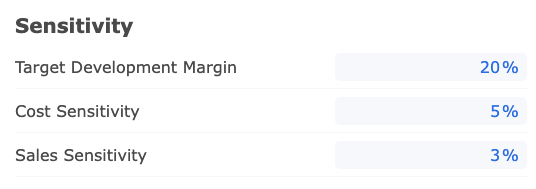
For our case study, we went with a 20% target development margin and cost sensitivity of 5% and a sale sensitivity of 3%.
Develop and sell scenario
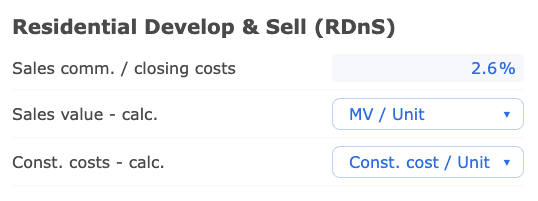
Land acquisition finance
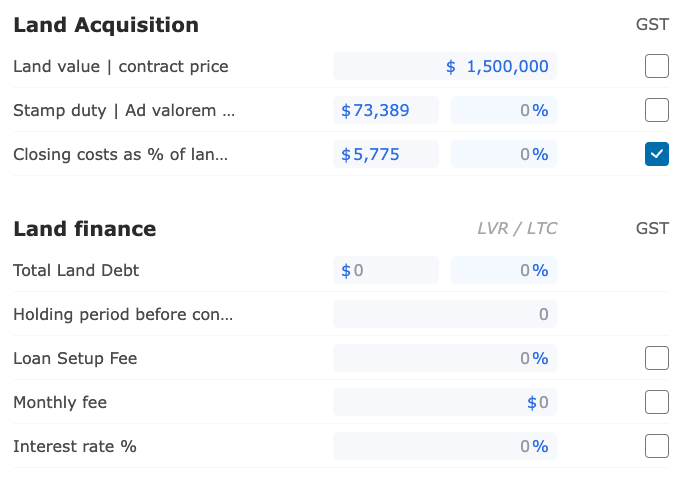
Since this project was a joint venture with the land owner, land finance was not required.
Residential units
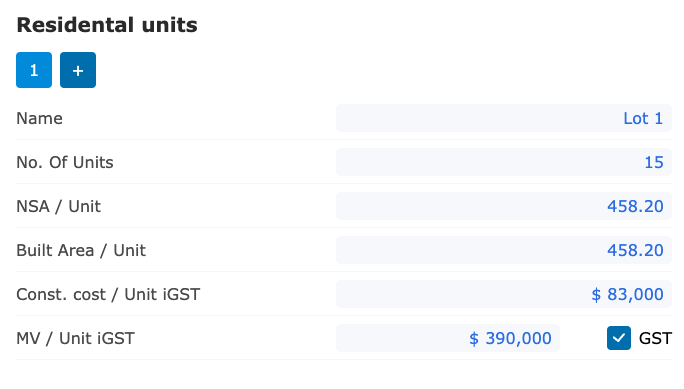
Land subdivision - Development costs


Environmental factors - Koala reserve
There were a lot of eucalyptus trees on the property. As the surveyor and planner indicated, an environmental assessment was required. Since we already knew about the Koala Reserve, we wanted to ensure we checked every box.
Geotechnical [soil report]
We might infer that everything was in order because the consulting engineer was familiar with the soil on site. To corroborate what we already knew and to enable the engineer to build the subgrade for the roadways, we did order a soil report prior to the engineering design stage.
Consultants, reports and permit-cost allowance


Services
Services were not a problem, as anticipated. In the road reserve in front of the site, there was drainage, reticulation, water supply, and a legal point of discharge.
Local government permits
Development permit (DA - development approval)
The surveyor created a preliminary subdivision plan that would result in 25 lots, and the engineer reviewed it. However, during the pre-lodgement meeting, along with our environmental consultant and town planner, we acknowledged the council's stand on protecting the koala reserve. We surrendered our right to negotiate and finally lodged a land subdivision application, which took approximately 8 months.
Engineering permit
The bulk earthworks, roads, sewage, water, and drainage were designed by the engineer as soon as the development permit was issued, read, and understood. When everything was done, the civil engineer pointed out the tender documents and a schedule of quantities. The plans were certified, verified by the council, and then certified again.
The landscape architect and electrical engineer were then tasked with designing the blueprints.
Development costs
In the case of land subdivision, it is a common practice to first, collect all consultant quotes and tender and then allow for costs based on per lot basis. In this scenario, for development costs and construction costs of land sub-division, we allowed $83000 / lot. The $83000 included costs for consultants, land subdivision, construction costs and all project soft costs.
Sales commissions and closing costs

Other costs

Funding table
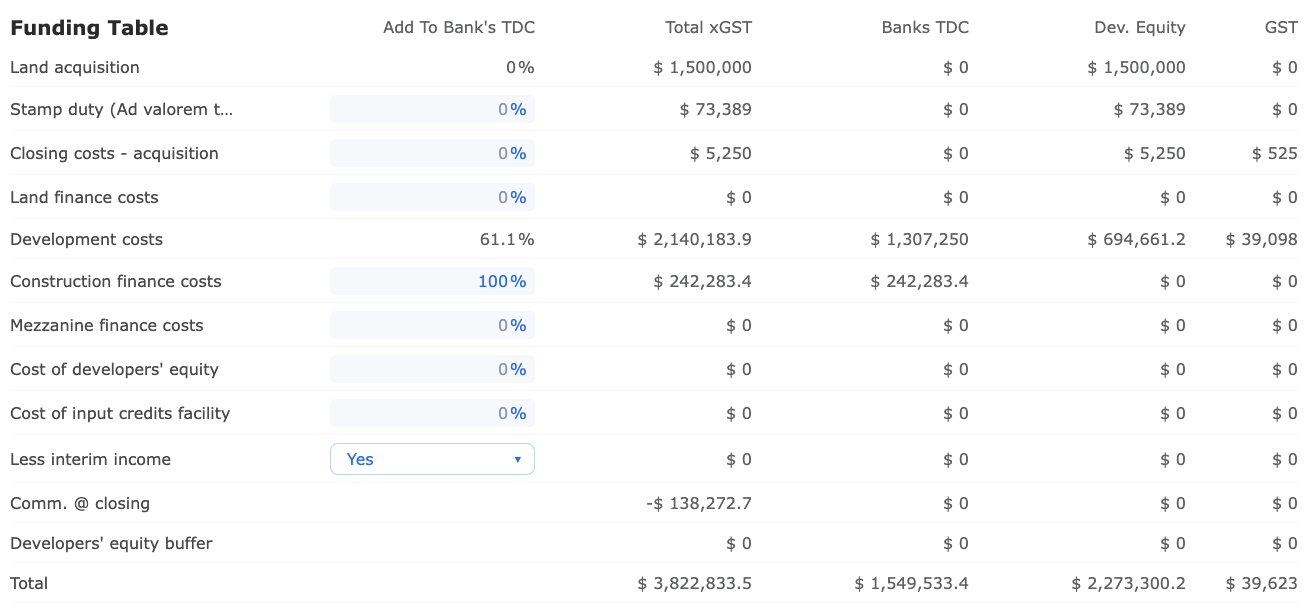
Funding options

Finance costs
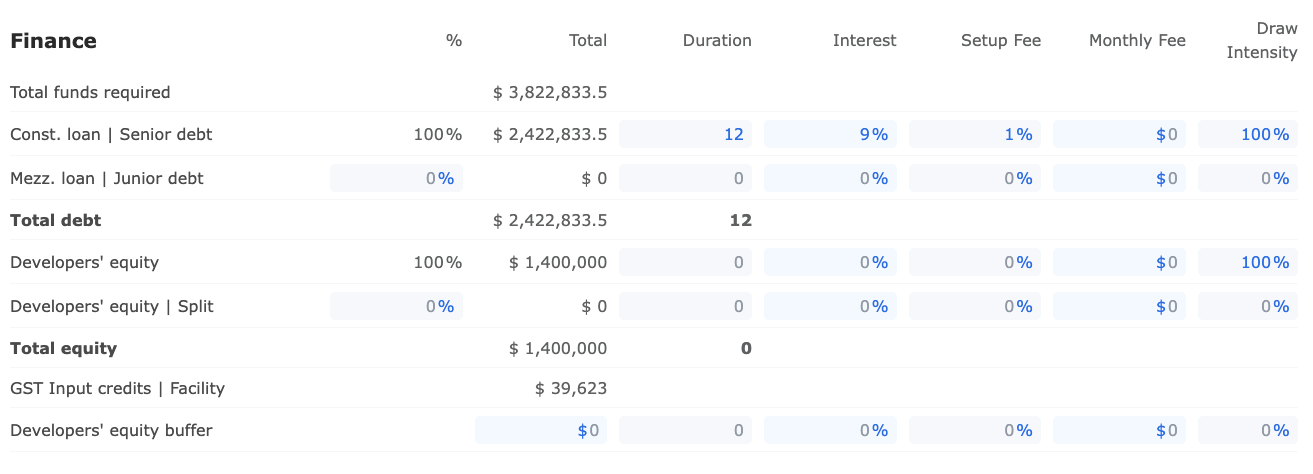
Project feasibility summary


